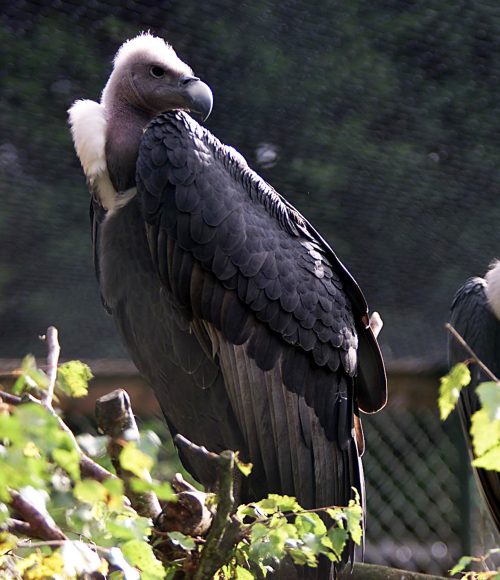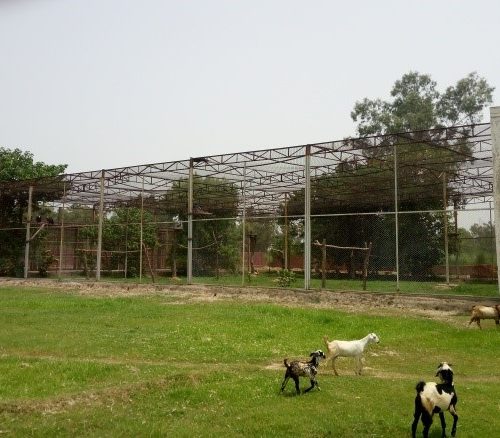
Since the mid-1990s, tens of millions of vultures in south Asia have died and three species have nearly disappeared after declining by over 99%. This massive decline is one of the most significant disasters to have ever befallen the natural world.
The primary cause of this disaster, and an ongoing threat to vultures, is a veterinary drug called diclofenac – a non-steroidal anti-inflammatory drug (NSAID) that is highly toxic to vultures if they feed on the carcass of an animal that has been treated with it shortly before death.
To address this problem and develop solutions, conservation organisations, governments and other organisations from around the world came together to form a conservation consortium known as SAVE (Saving Asia’s Vultures from Extinction). Conservation breeding centres are one of the major initiatives introduced to protect and breed remaining populations, followed by the development of Vulture Safe Zones for areas in the wild.
Diclofenac was effectively banned from veterinary use in south Asia during 2006, which was a huge step towards solving the problem, as the range country governments acted quickly to remove the threat. There is, however, still a threat to vultures from residual supplies of the drug and the illegal use of human-dose diclofenac for veterinary applications. A range of other NSAIDs, such as ketoprofen and aceclofenac, are also toxic to vultures and still need to be removed from circulation. Fortunately, there are vulture-safe drugs available, one of which is called Meloxicam, which is readily available and gradually being used more and more by livestock owners in the region.
In response to this crisis, the Hawk Conservancy Trust formed a working partnership with WWF-Pakistan to conserve vultures in Pakistan. Both the Trust and WWF-Pakistan are active members of SAVE.
Our Head of Conservation, Research and Education, Dr Campbell Murn, talks about our Pakistan Vulture Restoration Project.
The Hawk Conservancy Trust started working with Asian White-backed Vultures (Gyps bengalensis) in 1997, and in 2004 launched the Pakistan Vulture Recovery Project (PVRP) with WWF-Pakistan, forming a key project of the Trust’s International Vulture Programme.
The overall goals of the PVRP are simple and twofold:


To progress the goals of the project, a conservation breeding centre was built at a place called Changa Manga, located about 50 miles southwest of Lahore in the Punjab Province of Pakistan, officially opening in 2007. Building costs for the centre were provided by the Environment Agency in Abu Dhabi and the ongoing running costs are provided by the Trust. In 2012 a Vulture Safe Zone was created in Sindh Province in southeast Pakistan, across an area that contains the last remaining wild colony of Asian White-backed Vultures in Pakistan as well as an important colony of Long-billed Vultures (Gyps indicus).
In 2018 the project was expanded to also include the research and conservation of Red-headed Vultures (Sarcogyps calvus) and Egyptian Vultures (Neophron percnopterus).
Since project inception, the Trust has also been able to provide training and support for project staff in Pakistan, and it acts as the technical advisor for the project.
The PVRP has been supported by Ernest Kleinwort Charitable Trust, and the fundraising partners of the International Vulture Programme. It remains a long-term project and will continue to run until sufficient progress on the banning and reduced use of harmful NSAIDs is achieved.
The first vulture hatched in 2014 at the captive breeding centre in Changa Manga. There are now 33 Asian White-backed Vultures at the breeding centre, and we have successfully fledged two chicks most years since 2016.
Although several other drugs have been banned elsewhere in South Asia, Pakistan has so far prohibited only diclofenac. In 2025, the PVRP received additional funding to expand its national-level advocacy, aiming to strengthen regulations and push for the banning of other vulture-harmful NSAIDs. Pharmacy surveys conducted across the country have also highlighted regional differences in the availability of various NSAIDs, offering valuable scientific evidence to support ongoing advocacy efforts.
Find out more in-depth information about our findings from the following research papers that have been produced within this project:
Chaudhry, M. J. I. & Murn, C. (2022) The vulture restoration project in Pakistan. Hornbill (Jul-Sep): 80-85.
Murn, C., Saeed, U., Khan, U. & Iqbal, S. (2015) Population and spatial breeding dynamics of a Critically Endangered Oriental White-backed Vulture Gyps bengalensis colony in Sindh Province, Pakistan. Bird Conservation International 25: 415-425
Murn, C. P. & Khan, U. (2014) The Gyps Vulture Captive Breeding and Restoration Project in Pakistan. Pp 102-107 In: Lamont, M. M. (Ed.) Conservation through Aviculture: Proceedings of the 4th International Symposium on Breeding Birds in Captivity. 2007, Toronto, Canada. Hancock House Publishers, Surrey, Canada.
Murn, C. P., Khan, U. & Farid, F. (2011) Recent developments in Gyps vulture conservation in Pakistan. Vulture News 61: 27-30.
Khan, U. & Murn, C. (2011) Gyps Vulture Restoration Project – role of captive breeding in endangered species management. Journal of Animal and Plant Sciences 21(2): 405-409
Murn, C. (2011) Update on IAATE Grant helping critically endangered vultures in Pakistan. The Flyer 18(1): 12-13
Murn, C. (2009) IAATE grant helps vultures in Pakistan. The Flyer 16(4): 10-11
Murn, C. P., Khan, U. & Farid, F. (2008) Vulture populations in Pakistan and the Gyps Vulture Restoration Project. Vulture News 58: 35-43.
Murn, C. P., Khan, U., Farid, F. (2007) Pakistan’s Gyps Vulture Restoration Project. Wildlife Middle East News 2 (3): 3
Murn, C. P. (2003). The European Endangered Species Programme (EEP) for the Indian White-backed Vulture Gyps bengalensis: current status and future potential. Proceedings of the 4th North American Ornithological Conference. New Orleans, Louisiana, USA